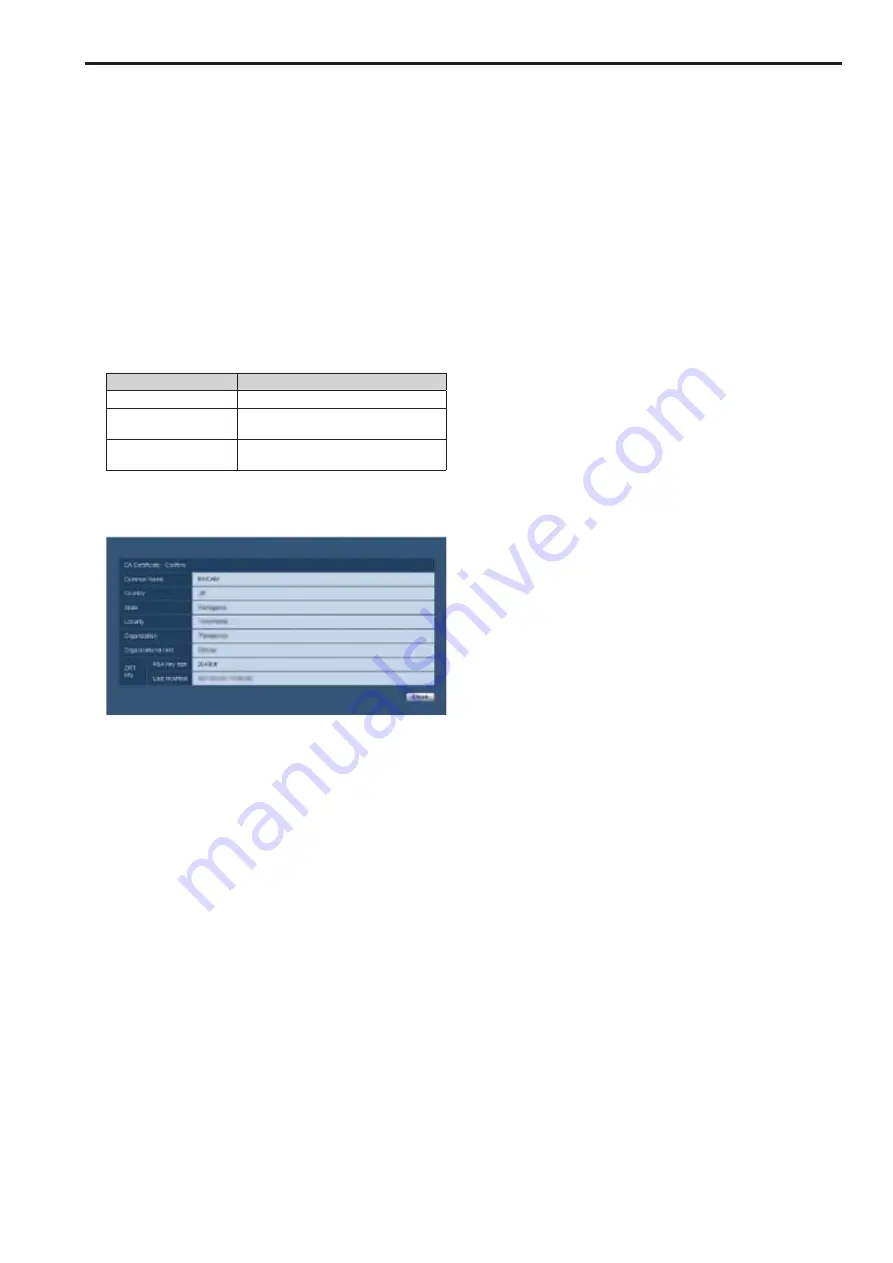
Installing a Server Certificate
(CA Certificate - CA Certificate install)
<NOTE>
• A server certificate (security certificate) cannot be installed if a
Certificate Signing Request (CSR) has not been generated.
• The server certificate must have been issued by the Certificate
Authority (CA) in order to install it.
1.
Click the “Browse” button in “CA Certificate - CA
Certificate install”
The “Open File” dialog is displayed.
2.
Select the server certificate file and click “Open”. Then
click the “Execute” button.
The server certificate is installed.
<NOTE>
• The name of the host registered to the installed server certificate
is displayed in “CA Certificate - Information”. The following is also
displayed depending on the status of the server certificate.
Displayed content
Description
Invalid
When the server certificate is not installed
Common name of the
server certificate
When the server certificate is already
installed and enabled.
Expired
When the effective period of the server
certificate has expired
• When the “Confirm” button is clicked, the content of the installed
server certificate (security certificate) is displayed in the “CA
Certificate - Confirm” dialog. (An asterisk is displayed in the
Organizational Unit Name field only.)
• Click the “Delete” button to delete the installed server certificate
(security certificate).
• When “HTTPS” is selected in “Connection Method”, the server
certificate (security certificate) cannot be deleted.
• Perform STEP 1 to STEP 2 to update a server certificate.
• To delete an enabled server certificate (security certificate),
confirm that there is a backup to the said certificate in your
personal computer or recording media. A server certificate (security
certificate) will be needed to reinstall it.
• The HTTPS function can no longer be used when the effective
period of the server certificate has expired. In such a case, the
connection method is changed to HTTP when the unit is restarted.
Update the server certificate before its effective period expires.
• The effective period of the server certificate can be confirmed by
double-clicking the server certificate file issued by the Certificate
Authority (CA).
Setting the Connection Method (Connection)
1.
Set the method to access the camera in “Connection”
HTTP: Only HTTP connection is possible.
HTTPS: Only HTTPS connection is possible.
2.
Set the Port No. to be used with HTTPS in “HTTPS Port”
Port Nos. that can be selected 1 to 65535
The following port numbers are used by the unit so they cannot be
used.
20, 21, 23, 25, 42, 53, 67, 68, 69, 80, 110, 123, 161, 162, 554, 995,
10669, 10670, 59000 to 61000
Factory settings:
443
3.
Click the “Set” button.
The camera restarts and access to the camera via HTTPS is enabled.
(→page@@, page @@)
<NOTE>
• This unit will restart if the connection method is changed.
•
Using a self-signed certificate
A warning screen is displayed when accessing the camera by
HTTPS for the first time. Install the self-signed certificate (security
certificate) in your personal computer in accordance with the screen
instructions. (→ page 165)
•
Using a server certificate
Install the Certificate Authority (CA) root certificate or intermediate
certificate in your browser in advance. Follow the Certificate
Authority (CA) procedures to acquire and install root certificates and
intermediate certificates.
• When accessing the camera by HTTPS, the image display speed
and frame rate of the moving image may reduce.
• When accessing the camera by HTTPS, it may take some time for
the images to be displayed.
• When accessing the camera by HTTPS, images may be disturbed
and sound may be interrupted.
• The maximum number of cameras that can be connected
simultaneously depends on the maximum image size and
distribution format.
Accessing the Camera by HTTPS
1.
Launch the web browser in your personal computer.
2.
Input the camera’s IP address in the address bar of the
web browser.
Input address: https://192.168.0.10/
<NOTE>
• When the HTTPS port No. is changed from “443”, input “https://
camera IP address: Port No.” in the address bar.
E.g. https://192.168.0.11:61443
• When this unit is in a local network, set a proxy server from the
web browser (menu bar: “Tools”-”Internet Options”) to ensure that a
proxy server is not used for a local address.
3.
Press the “Enter” key.
The Live screen page is displayed.
The security certificate is installed when the security warning screen
is displayed. (→page @@)
When “User Authentication” is set to “On”, the user name and
password input screen is displayed before the Live screen page
appears.
<NOTE>
• When HTTPS is used, screen and image display may slow down
and image update interval (frame rate) may also slow down.
98
99
Web screen configurations (continued)
Содержание AW-HE130KE
Страница 124: ...Index 124 ...
Страница 125: ...125 MEMO ...
















































